While having darshan (Vision) of a Deity or after meeting a respected individual, our hands automatically join in obeisance. ‘Paying obeisance’ that is doing namaskar is a sattvik (Sattva-predominant) impression on the Hindu mind, an act of maintaining the rich heritage of Hindu culture. Paying obeisance is a simple and beautiful act of expression of Divine qualities like devotion, love, respect and humility that bestows Divine Energy.
1. Why do we pay obeisance to the steps while entering a temple?
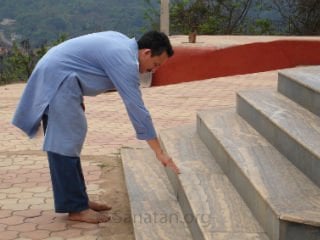
One should touch one step with the fingers of the right hand and move the same palm over the head.
Due to the movement of waves of Deities in the area around a temple, sattvikta is enhanced there. The presence of Chaitanya (Divine consciousness) in the area charges the steps of the temple too. Hence, there is a tradition of touching the steps with the fingers of the right hand and then moving the palm over the head. From this we understand that since the dust accumulated on the steps is also charged with Chaitanya, we have to respect it too and avail the benefit of Chaitanya in it as well. If the jiva has a bhav (Spiritual emotion) that, ‘the Chaitanya of the Deity, with which the steps have been charged is spreading all over my body through the hand’, it gives increased benefit to the jiva.
Climbing the steps is one of the activities, which increases the Raja component in the body. Hence, the Raja component is already activated in the body of a jiva. By touching the steps with the fingers of the right hand, the sattvik and peaceful waves from the charged premises, are transmitted into the body through the medium of the right hand, thus keeping a control on the Raja component in the body through the medium of Suryanadi (Sun channel). This means that for some time the activities of the Suryanadi remain under control. From this process, the jiva learns to enhance sattvikta through Raja component.
2. Why should we pay obeisance by standing next to
the statue of Nandi in a Shiva temple and Tortoise in other temples ?
While paying obeisance in the Shiva temple by standing next to a Nandi and in other temple by standing next to the Tortoise, one does not suffer from distress due to the sattvik waves emitted directly by the Deity’s Idol and they can be imbibed as per the requirement of the jiva.
3. Paying obeisance to God by performing sashtang namaskar
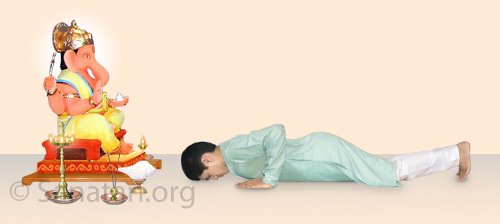
Sashtang namaskar means surrendering to God in all the three ways – physical, verbal and mental. This way Atmashakti (Energy of the soul) is awakened, which purifies the gross and the subtle body.
Method
- Join the palms at the chest level, bend at the waist and place the palms on the floor.
- Stretch the right leg back, then the left leg.
- Lie down with the elbows folded and eyes shut so that the head, chest, hands, knees and toes are in contact with the floor.
- Pay obeisance mentally to the Deity. Utter the word ‘namaskar’
- Stand up with the palms joined at the chest and pay obeisance with bhav.
4. Paying obeisance to the Deity with the hands joined
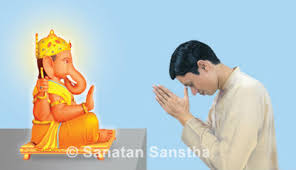
Whenever it is not possible to perform ‘sashtang namaskar’, pay obeisance with the hands joined.
A. Method
- While paying obeisance to God, to begin with, bringing the palms together. The fingers should be left loose while joining the hands or palms. The fingers should be kept close to each other, without leaving any space between them. The fingers should be kept away from the thumbs.
- After joining the hands, we should bow by bending at the waist and bow the head.
- At the same time, by bowing the head, we should place the thumbs in the mid-brow region, that is, at the point between the eyebrows and try to concentrate at the feet of the Deity.
- After that, instead of bringing the hands down immediately, hold them at the chest level for a while in such a way that the wrists are in contact with the centre of the chest; then lower the hands.
B. Underlying spiritual science
- The fingers should not be stiff while joining the palms, because this will lead to decrease in the Sattva component in the pranamay-kosh (Vital energy sheath) and manomay-kosh (Mental body sheath) and increase in the Raja component.
- In the posture of paying obeisance, the joined fingers act as an antenna to assimilate the Chaitanya and Shakti of God. While joining the palms, the fingers must touch each other, because leaving any space between the fingers will result in accumulation of energy in the that space. Since this energy is immediately transmitted in various directions, the seeker’s body loses the benefit received.
- After joining the palms, bend a little at the waist. This posture generates pressure on the chakra at the navel and activates the pancha-pran (Five vital energies) situated in this region. Activation of these panchapran in the body makes the body sensitive to absorbing sattvik waves. This later awakens the Atmashakti of the jiva. On the basis of this energy, bhav in the jiva is awakened. This enables it to imbibe maximum Chaitanya being emitted by the Deity.
- Touch the thumbs to the mid-brow region. This posture awakens a bhav of surrender in the jiva and in turn activates the appropriate subtle waves of Deities from the Universe. They enter through the Adnyachakra of the jiva and settle in the void parallel to it at the interior rear of the head. In this void, the openings of all the three channels, namely the Chandra (Moon channel), the Sushumna and the Surya converge. Due to the movement of subtler waves present in the void, the Sushumna-nadi gets activated. Consequently, it facilitates fast transmission of the waves throughout the body, leading to purification of both, the gross and subtle bodies at the same time.
- After paying obeisance, to imbibe the Chaitanya or Shakti (Divine Energy) of the Deity completely that has entered the hands, instead of bringing the hands down immediately, they should be brought to the mid-chest region in such a way that the wrists touch the chest. At the region of chest, the ‘Anahat-chakra’ is located. Akin to Adnya-chakra, the activity of Anahat-chakra also is to absorb sattvikta. By touching the wrists to the chest, the Anahat-chakra is activated and it helps in absorbing more sattvikta.
5. Why do we place our head on the
big toe of the Saint’s feet for paying obeisance ?
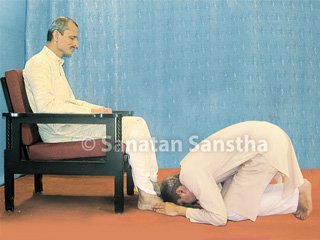
While paying obeisance to a Saint, place your head on the big toe of the Saint’s feet and place both the palms on the feet.
Men should perform sashtang namaskar to Saints. If the place is inadequate for this, then sit on the floor with knees folded and bend forward to pay obeisance. Women, however, should always pay obeisance by sitting on the floor with knees folded and then bending forward.
We can imbibe maximum Chaitanya through the Brahmarandhra. The part of head beginning above the forehead should be placed on the feet of Saints. Due to this, the Chaitanya emanating from the feet can enter to the maximum in the one paying obeisance.
The big toe of Saints emit maximum Chaitanya; hence, the head should be placed on the big toe instead of on the foot. If both big toes are in front of you, then the head should be placed on the right big toe.

 What should be done and what should be avoided while paying obeisance ?
What should be done and what should be avoided while paying obeisance ?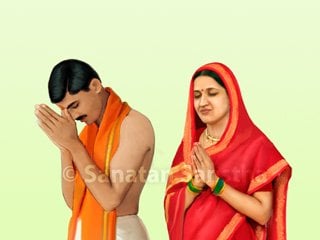 Methods of paying obeisance by husband and wife
Methods of paying obeisance by husband and wife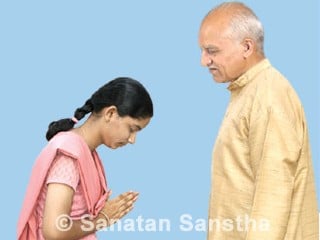 Paying obeisance – A simple act of expression of Divine qualities that bestows Divine Energy
Paying obeisance – A simple act of expression of Divine qualities that bestows Divine Energy Why ‘Namaskar’ and not a ‘hand shake’?
Why ‘Namaskar’ and not a ‘hand shake’?